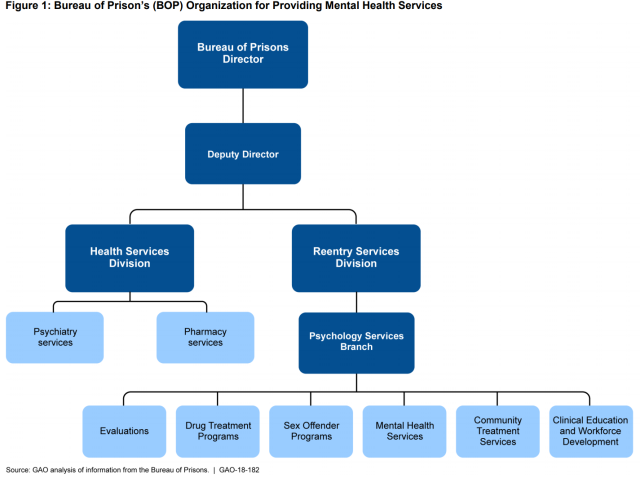Recidivism Among Prison Inmates with Serious Mental Illness
As of May 2017, the Federal Bureau of Prisons oversaw almost 188,000 inmates—and nearly 8,000 of them were considered to have a serious mental illness like schizophrenia or bipolar disorder.
Research has shown that prison inmates with serious mental illness are more likely to return to prison (that is, they have a higher recidivism rate). These inmates may face particular challenges on their release from prison that contribute to the cycle of repeated incarceration. For example, in addition to finding housing and a job, they may also need to find mental health treatment.
So, are there strategies that can reduce the cycle of repeated incarceration among prison inmates with serious mental illness? Today’s WatchBlog explores.
Federal guidance
Federal agencies, as well as criminal justice and mental health experts, have developed guidance for reducing recidivism among prison inmates with mental illness. This guidance includes:
- Assessing risk. Individuals should be screened as early in the booking process as possible and throughout their involvement in the criminal justice system to detect substance abuse and mental health disorders. An individual's risk of reoffending should also be assessed based on factors associated with recidivism—like criminal history, poor relationships with family, and antisocial personality traits.
- Planning treatment. Treatment approaches should be tailored to address mental health and substance abuse needs in prison and after release. Examples include psychopharmacology (which uses medications to reduce depression, psychosis, or anxiety) and cognitive behavioral therapy, which aims to address dysfunctional thoughts, moods, or behavior through counseling.
- Identifying post-release services. Correctional agencies and community treatment providers should help facilitate continuity of care as individuals leave prison—for example, by helping inmates apply for benefits like Medicaid or Social Security before their release.
- Coordinating with community-based providers. Correctional agencies should share information from assessments and treatment programs with community-based mental health care providers to avoid gaps in care.
What works?
We looked at 14 studies of correctional or reentry programs—9 of which found statistically significant reductions in recidivism among prison inmates with mental illness.
These reductions generally involved programs that offered multiple support services, such as mental health and substance abuse treatment, case management to coordinate services, and housing assistance.
To learn more, check out our full report.
- Comments on GAO’s WatchBlog? Contact blog@gao.gov.
GAO Contacts
Related Products

GAO's mission is to provide Congress with fact-based, nonpartisan information that can help improve federal government performance and ensure accountability for the benefit of the American people. GAO launched its WatchBlog in January, 2014, as part of its continuing effort to reach its audiences—Congress and the American people—where they are currently looking for information.
The blog format allows GAO to provide a little more context about its work than it can offer on its other social media platforms. Posts will tie GAO work to current events and the news; show how GAO’s work is affecting agencies or legislation; highlight reports, testimonies, and issue areas where GAO does work; and provide information about GAO itself, among other things.
Please send any feedback on GAO's WatchBlog to blog@gao.gov.






